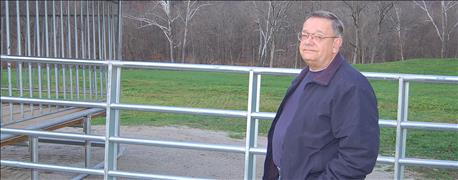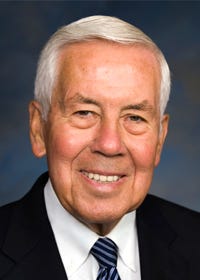
The year was 1984. The farm economy was at low tide, with many people struggling after a land price crash bigger than any in 50 years. The government’s program to idle acres in 1983 helped, assisted by a drought, but the outlook for future prices was still in doubt. Decades of set-aside and soil bank and other programs had produced a yo-yo effect on limiting production and improving prices, at best.

LONGTIME CONSERVATIONIST REMEMBERS: Duane Drockelman remembers the ceremonious kickoff to CRP on Richard Lugar’s farm like it was yesterday.
Along came debate in preparation for passing a farm bill in 1985. Indiana Sen. Richard Lugar hit on a new idea. Instead of a piecemeal program to get farmers to not farm acres to cut production, why not pay them rent on land that they agreed not to farm for at least 10 years? And why not accept only the most marginal, fragile land into that program? Production would go down, and land needing protection would get covered year-round at the same time.
Lugar shepherded an idea made that sense through Congress. It was given an appropriate name: the Conservation Reserve Program. It was passed as part of the farm bill, and USDA began devising plans to implement it.
Maybe Lugar knew how important this program, which has lasted 30 years, would become — maybe not. At any rate, he wanted to kick it off right and attract attention to it. So he set up an event on his own farm in Marion County, near Camby, to make the official announcement about the program.
Duane Drockelman remembers the scene well. At the time he was a district conservationist in Johnson County. He made the short trek to Lugar’s farm on the day of the event.

INDIANA LEADER STARTED CRP: Politicians seldom agree, but likely none would argue that Indiana's Sen. Richard Lugar is the father of the Conservation Reserve Program.
“Lugar was all about planting trees,” Drockelman recalls. “He made it clear that he hoped lots of trees would be planted on land enrolled and accepted into the new CRP program.”
If that happened, the land would be permanently removed from production, and protected from erosion. As it turned out, thousands of acres were planted to trees, but many more were maintained in grass as cover.
Drockelman eventually moved to Marion County, finishing his career with the Natural Resources Conservation Service there. Then he returned to his native Ripley County and was a watershed coordinator for an important project. Today he’s retired, but he has CRP land on his farm. He took time to attend the 30th anniversary celebration of CRP, sharing memories of the day the whole country watched an Indiana senator walk across his own farm in Marion County, kicking off what would become an iconic program.
About the Author(s)
You May Also Like




